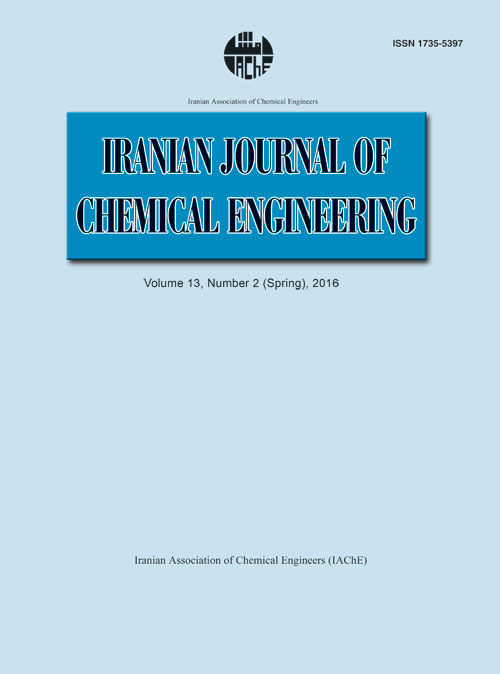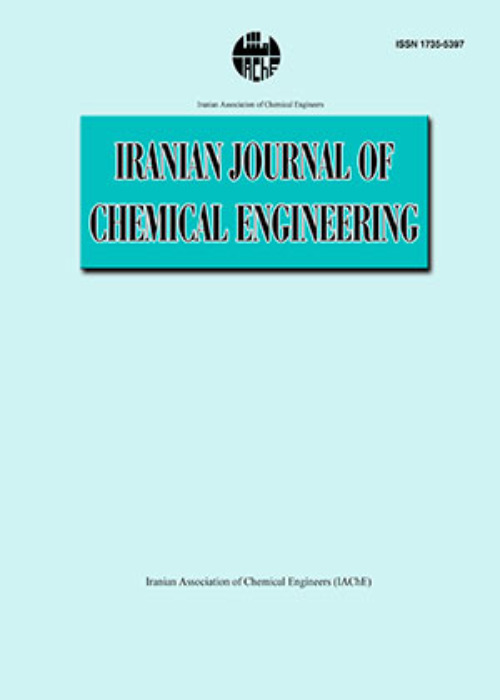فهرست مطالب

Iranian journal of chemical engineering
Volume:13 Issue: 2, Spring 2016
- تاریخ انتشار: 1394/12/15
- تعداد عناوین: 7
-
-
Pages 3-21Adsorption of Ce(III) from aqueous solution by amino phosphate modified nano TiO2 was investigated. Effects of pH of solution, adsorbent dose, contact time, initial metal concentration and temperature were examined. Experimental data were fitted well bythe pseudo second order model. Adsorption was well described by Freundlich isotherm model with a maximum adsorption capacity of 25 mg/g. According to the obtained thermodynamic parameters, the adsorption was a spontaneous and endothermic process. Effect of interfering cations was studied. Distribution coefficient value for Ce(III) was higher than La(III). Regeneration of adsorbent was performed using HNO3 with efficiency greater than 84%.Keywords: Adsorption Nano TiO2 Phosphate Functionalization Ce(III) Coefficient Distribution
-
Pages 22-32e"> The ultrasound-assisted (UA) soybean oil methanolysis using KOH as a catalyst was studied at different reaction conditions in a microreactor. Box–Behnken experimental design, with three variables, was performed and the effects of three reaction variables, i.e., reaction temperature, catalyst concentration and the methanol-to-oil molar ratio on fatty acid methyl ester (FAME) yield were evaluated by method of analysis of variance (ANOVA) and multiple regression. A quadratic polynomial model was obtained to predict the methyl ester yield. A yield of 97.1% for methyl ester was obtained at the deduced optimal conditions: reaction temperature of 47°C, KOH catalyst concentration of 1.29 (w/w%) and methanol-to-oil molar ratio of 6:1. Validation experiments confirmed the validity of the predicted model.At the optimal operation condition for the ultrasonic process, ahigher yield of methyl esters was obtained in comparison with thatof the non-ultrasonic layout. The results show that UAtransesterification in microreactor minimizes the reaction time andtemperature, alcohol-to-oil molar ratio as well as energyconsumption.Keywords: Ultrasound Microreactor Biodiesel Response Surface Methodology Transesterification
-
Pages 33-45Energy crisis is a major challenge in the current world. Latent heat thermal energy storage (LHTES) systems are known as equipment with promising performance by which thermal energy can be recovered. In the present study a comprehensive theoretical and experimental investigation is performed on a LHTES system containing PEG1000 as phase change material (PCM). Discussed topics can be categorized in three parts. At first, a one dimensional mathematical model is introduced for a heat exchanger containing flat slabs of PCM. To consider the latent heat of phase change, effective heat capacity is used in the model. Secondly, through eight experiments designed by using factorial method, effects of inlet air velocity and temperature on the outlet stream is investigated. The results proved that having a determined temperature difference between inlet air and the PCM in both hot and cold cycles can enhance the efficiency. Finally, the feasible applications of a LHTES system for controlling the temperature swing in a greenhouse is studied numerically and the results are compared with experimental values. As a result, by using this passive coolant system diurnal internal temperature can be reduced for 10°C.Keywords: Phase Change Material Latent Heat Thermal Energy Storage Greenhouse Passive Cooling
-
Pages 46-56In the Bayer process, the reaction of silica in bauxite with caustic soda causes the loss of a great amount of NaOH. In this research, the bound-soda losses in Iran Alumina Complex solid residue (red mud) are predicted using intelligent techniques. This method, based on the application of regression and artificial neural networks (AAN), has been used to predict red mud bound-soda losses in Iran Alumina Company. Multilayer perceptron (MLP), radial basis function (RBF) networks and multiple linear regressions (MLR) were applied. The results of three methodologies were compared for their predictive capabilities in terms of the correlation coefficient (R), mean square error (MSE) and the absolute average deviation (AAD) based on the experimental data set. The optimum MLP network was obtained with structure of two hidden layers including 13 and 15 neurons in each layer respectively. The results showed that the RBF model with 0.117, 5.909 and 0.82 in MSE, AAD and R, respectively, is extremely accurate in prediction as compared with MLP and MLR.Keywords: Neural Network Linear Regression Bound, Soda Red Mud Bayer Process
-
Pages 57-70In this study a developed model has been used to evaluate the paper drying process and examine the pocket dryer conditions of a multi-cylinder fluting paper machine. The model has been developed based on the mass and energy balance relationships in which the heat of sorption and its variations with paper temperature and humidity changes have been taken into account. The applied model can be used to compute the drying parameters and analyze the pocket drying conditions. Furthermore, the effects of web tension on the heat transfer have been investigated. In the available operating range of the web tension, the overall mean heat transfer coefficient will be within 300-550 W/m2.K. The pocket air temperature was between 50 and 90oC. The dew point temperature was not close to the pocket air temperature and dew drop never happened during the dryer section.Based on the modeling result and using a novel technique, the maximum level for the exhaust air in the studied machine can be estimated to be 0.2 kg H2O/kg dry air. Result shows that increasing the exhaust humidity to the optimal level will lead to 4% reduction in the required energy and 20% rise in the heat recovery potential. Accordingly the specific heat consumption per evaporated water for the studied drying section can be reduced from 3.96 to 3.81 GJ per ton water.Keywords: Paper Drying Multi, Cylinder Dryers Pocket Dryer Dew Point Drying Model Web Tension
-
Pages 71-79Bioremediation of soil contaminated by polycyclic aromatic hydrocarbons (PAHs) was studied using Bacillus subtilis DSMZ 3256 (B.subtilis) strains. The effect of electrokinetics on biodegradation of PAH was investigated. Fluorene and phenanthrene as selected PAHs were mixed with soil. The bioremediation experiments were initially performed at 30°C and different humidities. The biodegradation percentages of fluorene and phenanthrene after 7 days at 40% relative humidity were 12.2 and 11.9%, respectively. The effects of electrokinetics on this process were studied at different current densities. It was found that the electrokinetic can accelerate the biodesulfurization rate. According to the results, the removal percentages of fluorene and phenanthrene after 4 days under current density of 1.82 mA/cm2 were 39.4 and 37.2, respectively.Keywords: Electrokinetic Fluorine Phenanthrene Bioremediation Bacillus Subtilis
-
Pages 80-87Ultrasound assisted phase-transfer catalyzed preparation of ethyl 2-(4-nitrophenoxy)acetate from the corresponding p-nitrophenol and ethyl 2-bromoacetate using the mild solid base, anhydrous potassium carbonate, under very mild conditions is reported. The solid-liquid reactions were performed in a batch reactor equipped with reflux condenser, and ultrasonic irradiations were introduced using an ultrasonic bath operating at a frequency of 28 kHz with a power rating of 300 W. The reaction was carried out at 50°C under pseudo-first order conditions and was monitored by gas chromatography (GC). From the experimental data, a rate expression had been developed to explain the kinetic behavior of the reaction from which the apparent rate constant (kapp) of the organic phase was attained. The effects of different operating parameters such as stirring rate, temperature, catalyst loading and kind of Phase-transfer catalysts, base variation and quantity of water, and kind of solvents have been investigated to maximize the yield of synthesis of ethyl 2-(4-nitrophenoxy)acetate.Keywords: Solid, Liquid PTC P, Nitrophenol Sonocatalysis Ethyl 2, Bromoacetate Chemical Kinetics


